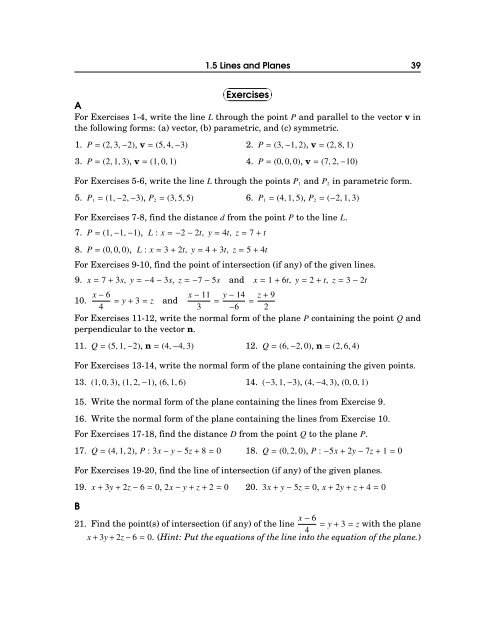Michael Corral: Vector Calculus
Michael Corral: Vector Calculus
Michael Corral: Vector Calculus
You also want an ePaper? Increase the reach of your titles
YUMPU automatically turns print PDFs into web optimized ePapers that Google loves.
1.5 Lines and Planes 39<br />
☛ ✟<br />
✡Exercises<br />
✠<br />
A<br />
For Exercises 1-4, write the line L through the point P and parallel to the vector v in<br />
the following forms: (a) vector, (b) parametric, and (c) symmetric.<br />
1. P=(2,3,−2), v=(5,4,−3) 2. P=(3,−1,2), v=(2,8,1)<br />
3. P=(2,1,3), v=(1,0,1) 4. P=(0,0,0), v=(7,2,−10)<br />
For Exercises 5-6, write the line L through the points P 1 and P 2 in parametric form.<br />
5. P 1 = (1,−2,−3), P 2 = (3,5,5) 6. P 1 = (4,1,5), P 2 = (−2,1,3)<br />
For Exercises 7-8, find the distance d from the point P to the line L.<br />
7. P=(1,−1,−1), L : x=−2−2t, y=4t, z=7+t<br />
8. P=(0,0,0), L : x=3+2t, y=4+3t, z=5+4t<br />
For Exercises 9-10, find the point of intersection (if any) of the given lines.<br />
9. x=7+3s, y=−4−3s, z=−7−5s and x=1+6t, y=2+t, z=3−2t<br />
x−6 x−11<br />
10. = y+3=z and = y−14 = z+9<br />
4<br />
3 −6 2<br />
For Exercises 11-12, write the normal form of the plane P containing the point Q and<br />
perpendicular to the vector n.<br />
11. Q=(5,1,−2), n=(4,−4,3) 12. Q=(6,−2,0), n=(2,6,4)<br />
For Exercises 13-14, write the normal form of the plane containing the given points.<br />
13. (1,0,3), (1,2,−1), (6,1,6) 14. (−3,1,−3), (4,−4,3), (0,0,1)<br />
15. Write the normal form of the plane containing the lines from Exercise 9.<br />
16. Write the normal form of the plane containing the lines from Exercise 10.<br />
For Exercises 17-18, find the distance D from the point Q to the plane P.<br />
17. Q=(4,1,2), P : 3x−y−5z+8=0 18. Q=(0,2,0), P :−5x+2y−7z+1=0<br />
For Exercises 19-20, find the line of intersection (if any) of the given planes.<br />
19. x+3y+2z−6=0, 2x−y+z+2=0 20. 3x+y−5z=0, x+2y+z+4=0<br />
B<br />
21. Find the point(s) of intersection (if any) of the line x−6 = y+3=zwith the plane<br />
4<br />
x+3y+2z−6=0. (Hint: Put the equations of the line into the equation of the plane.)








